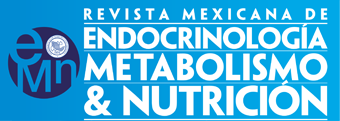Resumen
Cross-sectional study of dietary fatty acid intake and its association to high blood pressure in a group of mexican adolescents
Estudio transversal: ingestión de ácidos grasos y su asociación con la hipertensión en un grupo de adolescentes mexicanos
VOLUMEN 4 - NÚMERO 2 / Abril - Junio (Artículos originales / Original articles)
Manuel A Gómez-Martínez, Heart Failure and Respiratory Clinic, Instituto Nacional de Enfermedades Respiratorias, Mexico City, Mexico
Lilia Castillo-Martínez, Servicio de Nutriología Clínica, Instituto Nacional de Ciencias Médicas y Nutrición Salvador Zubirán. Ciudad de México, México
Carolina Velázquez-Aguilar, Clinical Nutrition Department, Medical Sur Hospital, Mexico City, Mexico
Arely Vergara-Castañeda, Chemical Science Department, La Salle University, Mexico City, Mexico
Maria del Pilar Milke-García, Nutrition Division, Instituto Nacional de Ciencias Médicas y Nutrición Salvador Zubirán, Mexico City, Mexico
Arturo Orea-Tejeda, Department of Cardiology, Instituto Nacional de Enfermedades Respiratorias Ismael Cosío Villegas, Mexico City, Mexico
Objective: To examine the relationship between fatty acid consumption and blood pressure in high school adolescents. Methods: A cross-sectional study was conducted in 247 adolescents (low-income families) attending public schools in Mexico City. Blood pressure was measured according to the National High Blood Pressure Education Program Working Group on High Blood Pressure in Children and Adolescents recommendations. Hypertension was defined as a blood pressure above the 95th percentile for the age, gender, and height. Also weight, height, and waist circumference were measured and the waist-to-height ratio was calculated accordingly. Dietary intake was estimated by analyzing a 24-hour recall through the Food Processor ESHA research Software. Body mass index was calculated and subjects were classified in categories according to the CDC percentiles. Results: The frequency of hypertension was 15.39%. The dietary intake variables did not differ between the individuals having high blood pressure or normal blood pressure, except for the ratio of omega 6/3. High blood pressure was associated to body mass index and total fat intake > 30%, disregarding age, waistto- height ratio, dietary kilocalories or omega 6/3 ratio. Conclusions: High blood pressure was frequent in school adolescents of low socioeconomic status living in Mexico City. Body mass index and dietary fat consumption > 30% of the caloric intake were associated to high blood pressure in this
population.
Palabras clave: Adolescents. Hypertension. Omega 6/3 ratio. Fatty acid intake.
Artículo completo en PDF



